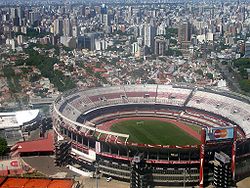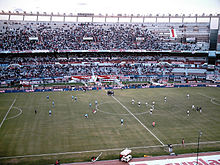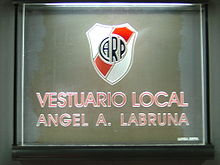- Estadio Monumental Antonio Vespucio Liberti
-
River Plate Stadium El Monumental Full name Estadio Monumental Antonio Vespucio Liberti Former names Estadio Monumental (1938–1986) Location Buenos Aires Built 1936–1938 Opened May 25, 1938 Renovated 1978 Owner River Plate Surface grass Architect José Aslan
Héctor EzcurraCapacity 74.624[1][2][3] Field dimensions 105 x 68 m Tenants Argentine national football team
River PlateEstadio Monumental Antonio Vespucio Liberti, is a stadium in the Belgrano district of Buenos Aires, Argentina at the intersection of Figueroa Alcorta and Udaondo. It is the home venue of Club Atlético River Plate and is named after former club president Antonio Vespucio Liberti. El Monumental is considered to be the national stadium of Argentina.
Contents
History
River Plate was founded in 1901 and by 1934, they had won both an amateur and professional championship. At the time the club was known as Los Millonarios, or The Millionaires, because they would purchase players at higher prices than normal at the time. On October 31, 1934, River Plate purchased the land where the club was to build the new stadium in the neighborhood of Nuñez.
On May 25, 1935, the cornerstone was laid on the campus of Centennial Avenue and River Plate. On December 1 of that year, the Steering Committee presented the approved project in detail to its members at an assembly. They obtained a loan of $2,500,000 from the government and on September 27, 1936, construction began under the direction of architects José Aslan and Héctor Ezcurra.
The initial cost of work reached the figure of $4,479,545.80, but decreased about 3 million dollars when the committee decided to halt the construction of the north end of the stadium.
A distinctive feature of construction was to be the foundations; six or eight feet deep. This required open pit excavation for the stability of the ground , and pumping bilge water from the site. The construction of the three stands were completed in two years. There are 50 km of steps, with 26,000 square meters of reinforced concrete and almost 3,000 tons of steel. A few years later , during World War II, the steel used would have cost more than the whole stadium.
May was also the month chosen to inaugurate the new stadium. On Wednesday the 25th, about 8,000 people witnessed the placement of an Argentine flag and one from the club, paid for by a group of associates, and sang the national anthem and the progress of River Plate.
The next day, the festival brought together nearly 120,000 spectators. After various activities the great evening was completed with the match played between River and Peñarol from Uruguay, with a 3–1 victory for the home team.
Reforms
1958
The horseshoe was fully enclosed in 1958, under the club presidency of Enrique Pardo. The new construction, the Colonia stand, was financed by the proceeds from the 10M pesos transfer of Omar Sivori to Juventus of Italy. With these changes the capacity reached 130,000.
1978
The accomplishment of the World Cup one of 1978 motivated that – with a lending of the Military Government to River Plate – the stadium was remodelled completely. River Plate was late many years in paying the corresponding quotas due to the changes of currency, which harmed it notably.
One of the largest attendances in the Monumental was a promotion game between San Lorenzo and Tigre, in which San Lorenzo (which did not have a stadium at the time) brought 74,000 people to River's stadium. When River played Racing for the title (after 18 years) 100,000 were present. At the end the 1986 and 1996 Copa Libertadores second-leg finals (both against América de Cali), seats were added and approximately 85,000 spectators were in attendance. It is also estimated that for the Argentina versus Uruguay 1987 Copa América semifinal more than 87,000 spectators attended.
The total length of the seating in the stands of the stadium is over 70 kilometers.
Facilities
The stadium has room for 57,921 people, and was renewed for the 1978 World Cup; the opening and final matches were both held in the Monumental, which had a capacity of 76,600 at the time because all of the popular stands were standing-only.
The stadium complex also has facilities for tennis, basketball, and other sports, as well as living quarters for young footballers, a theatre hall, a parking lot, museum etc. It can be accessed by several train and bus lines, as it is located within walking distance from the Barrancas de Belgrano transportation hub. Contrary to most other stadiums in the Buenos Aires area, there is a sizable car park by the stadium.
Sporting events held
The Monumental, aside from being where River Plate plays as host team, is also the stadium where the Argentine National Football Team usually plays as host, in events such as the FIFA World Cup qualification.
Rugby union matches featuring the Argentina national rugby union team, Los Pumas, also take place occasionally in this field, although the Pumas more frequently play at another Buenos Aires venue, Vélez Sársfield.
The Monumental also hosted the closing ceremonies and the athletics events of the First Pan American Games in 1951.
Concerts
When an international music superstar or band comes to Buenos Aires, their concerts are usually held in this stadium, as it is the biggest in the city and in all of Argentina.
The stadium played host to Amnesty International's final Human Rights Now! Benefit Concert on October 15, 1988. The show was headlined by Sting and Peter Gabriel and also featured Bruce Springsteen & The E Street Band, Tracy Chapman, Youssou N'Dour, León Gieco and Charly García.
David Bowie Sound+Vision Tour was held in September 29, 1990. He sold more than 81,900 tickets from one only show.[citation needed]
On July 16–17, 1993, Guns N' Roses performed the final concerts of their Use Your Illusion Tour, marking their last performance with most of their original lineup.
During his Dangerous World Tour, Michael Jackson performed 3 sold-out concerts in October 8th, 10th and 12th, 1993, in front of 300,000 spectators.
Seminal punk rock band The Ramones played their final South American show on March 16, 1996.
Soda Stereo currently holds the record for the highest number of concerts in the stadium. The band played six sold out concerts in 2007, during their Me Veras Volver Reunion Tour.
Madonna performed 2 sould-out concerts in October 1993[4] and another 4 in December 2008, during her Sticky & Sweet Tour; during two of these concerts, an official DVD of the tour was filmed. She holds the record for fastest sell out concert at the stadium for her first show, with 3 hours and more than 263,000 tickets sold.
In 2009 the British band Oasis offer one of the biggest concerts of their history, Noel Gallagher and the Argentine public sharing an emotional moment, playing "Don't Look Back In Anger".
AC/DC performed three sold out shows in December 2009, during their Black Ice World Tour. These shows were filmed and released on the DVD and Blu-ray Live at River Plate, released in May 2011.
Legendary New Jersey rockers Bon Jovi have played the stadium numerous times, most recently in 2010 as part of The Circle Tour.
In May 2011, Miley Cyrus brought her Gypsy Heart Tour which sold out in a week.
Roger Waters is scheduled to perform a record setting nine concerts at the stadium in March 2012. He and his band will be performing The Wall in its entirety on their 2010-2012 The Wall Live tour.[5]
1978 FIFA World Cup
The stadium served as venue for the following matches during the world cup:
Date Round Group Team 1 Vs. Team 2 June 1 1 2  West Germany
West Germany0–0  Poland
PolandJune 2 1 1  Argentina
Argentina2–1  Hungary
HungaryJune 6 1 1  Argentina
Argentina2–1  France
FranceJune 10 1 1  Italy
Italy1–0  Argentina
ArgentinaJune 14 2 A  West Germany
West Germany0–0  Italy
ItalyJune 18 2 A  Italy
Italy1–0  Austria
AustriaJune 21 2 A  Netherlands
Netherlands2–1  Italy
ItalyJune 24 Third place  Brazil
Brazil2–1  Italy
ItalyJune 25 Final  Argentina
Argentina3–1 (AET)  Netherlands
NetherlandsSee also
 Media related to Estadio Antonio Vespucio Liberti at Wikimedia Commons
Media related to Estadio Antonio Vespucio Liberti at Wikimedia Commons- Club Atlético River Plate
- Antonio Vespucio Liberti
- List of association football stadiums by capacity
References
External links
- Sitio Oficial del Club Atlético River Plate
- Stadium picture
- Club Atlético River Plate official history
- In depth history of 'El Monumental'
- History of the stadium 'El Monumental' (written by fans)
Preceded by
Estadio Nacional
SantiagoCopa América
Final Venue
1946Succeeded by
Estadio George Capwell
GuayaquilPreceded by
Estadio Nacional
LimaCopa América
Final Venue
1959Succeeded by
Estadio Modelo
GuayaquilPreceded by
Olympiastadion
MunichFIFA World Cup
Final Venue
1978Succeeded by
Santiago Bernabéu
MadridPreceded by
two-legged finalCopa América
Final Venue
1987Succeeded by
Estádio do Maracanã
Rio de JaneiroPreceded by
Estadio José Pachencho Romero
MaracaiboCopa América
Final Venue
2011Succeeded by
incumbentClub Atlético River Plate Founded May 25, 1901Club Stadiums Estadio Alvear y Tagle · El MonumentalRivals Key Personnel National Titles (33) 1932 · 1936 · 1937 · 1941 · 1942 · 1945 · 1947 · 1952 · 1953 · 1955 · 1956 · 1957 · 1975 Metropolitano · 1975 Nacional · 1977 Metropolitano · 1979 Metropolitano · 1979 Nacional · 1980 Metropolitano · 1981 Nacional · 1985-86 · 1989-90 · 1991 Apertura · 1993 Apertura · 1994 Apertura · 1996 Apertura · 1997 Apertura · 1997 Clausura · 1999 Apertura · 2000 Clausura · 2002 Clausura · 2003 Clausura · 2004 Clausura · 2008 ClausuraInternational Titles (5) 1986 Copa Libertadores · 1986 Intercontinental Cup · 1987 Copa Interamericana · 1996 Copa Libertadores · 1997 Supercopa SudamericanaSupporters Website: www.cariverplate.com1978 FIFA World Cup stadiums El Monumental (Buenos Aires) · José Amalfitani (Buenos Aires) · Córdoba (Córdoba) · José María Minella (Mar del Plata) · Gigante de Arroyito (Rosario) · Malvinas Argentinas (Mendoza)23 de Agosto · Arquitecto Ricardo Etcheverry · Bautista Gargantini · Centenario · Chacarita Juniors · Don León Kolbovski · El Bosque · El Serpentario · Fragata Presidente Sarmiento · Gigante de Arroyito · José Antonio Romero Feris · José Manuel Moreno · José María Minella · Monumental · Monumental José Fierro · Monumental Presidente Perón · Norberto Tomaghello · Presbítero Bartolomé Grella · Raúl Conti · Tomás Adolfo Ducó ·
 Monumental (Buenos Aires) · 23 de Agosto (Jujuy) · Mario Alberto Kempes (Córdoba) · Ciudad de La Plata (La Plata) · Brigadier Estanislao López (Santa Fe) · Malvinas Argentinas (Mendoza) · Del Bicentenario (San Juan) · Padre Ernesto Martearena (Salta)
Monumental (Buenos Aires) · 23 de Agosto (Jujuy) · Mario Alberto Kempes (Córdoba) · Ciudad de La Plata (La Plata) · Brigadier Estanislao López (Santa Fe) · Malvinas Argentinas (Mendoza) · Del Bicentenario (San Juan) · Padre Ernesto Martearena (Salta)Pan American Games Stadiums Buenos Aires 1951 • Mexico City 1955 • Chicago 1959 • São Paulo 1963 • Winnipeg 1967 • Cali 1971 • Mexico City 1975 • San Juan 1979 • Caracas 1983 • Indianapolis 1987 • Havana 1991 • Mar del Plata 1995 • Winnipeg 1999 • Santo Domingo 2003 • Rio de Janeiro 2007 • Guadalajara 2011 • Toronto 2015FIFA World Cup Final venues Uruguay 1930 • Italy 1934 • France 1938 • Brazil 1950 • Switzerland 1954 • Sweden 1958 • Chile 1962 • England 1966 • Mexico 1970 • West Germany 1974 • Argentina 1978 • Spain 1982 • Mexico 1986 • Italy 1990 • United States 1994 • France 1998 • Korea/Japan 2002 • Germany 2006 • South Africa 2010 • Brazil 2014 • Russia 2018 • Qatar 2022Landmarks of Buenos Aires Note: "Buenos Aires" denotes the city of Buenos Aires proper, not the entire Greater Buenos Aires metropolitan area.Public
& historic buildings
and structuresArgentine Congress · Torre Monumental · Cabildo · Café Tortoni · Casa Rosada · Central Post Office · City Hall · City Legislature · Customs House · Duhau Palace · Estrugamou Building · Floralis Genérica · Galerías Pacífico · Hotel de Inmigrantes · Kavanagh building · Libertador Building · Metropolitan Cathedral · Monument to Giuseppe Garibaldi · Obelisk of Buenos Aires · Palacio Barolo · May Pyramid · Pizzurno Palace · Plaza Hotel · Recoleta Cemetery · San Martín Palace · Sarmiento Frigate · Uruguay Corvette · The Water Company Palace · Women's BridgePrecincts
& neighbourhoodsAlmagro · Belgrano · Buenos Aires CBD · Caballito · City Centre · Colegiales · Montserrat · Núñez · Palermo · Puerto Madero · Recoleta · Retiro · San TelmoNature and parks Avellaneda Park · Botanical gardens · Buenos Aires Ecological Reserve · Chacabuco Park · Congressional Plaza · Japanese Gardens · Lezama Park · Palermo gardens · Plaza de la República · Plaza de Mayo · Plaza San Martín · Parque Centenario · Buenos Aires ZooCultural
InstitutionsEl Ateneo Bookstore · Argentine Automobile Club · Bernardino Rivadavia Natural Sciences Museum · Buenos Aires Museum of Modern Art · Café Tortoni · Fortabat Art Collection · House of Culture · Illuminated Block · Isaac Fernández Blanco Museum · King Fahd Cultural Center · Latin American Art Museum · Museum of Foreign Debt · National Library · National Museum of Decorative Arts · National Museum of Fine Arts · National Museum of History · Opera House · Paz Palace · Planetarium · Recoleta Cultural Center · San Martín Cultural Center · San Martín National Institute · Sarmiento Museum · Eduardo Sívori MuseumSport Bombonera Stadium · River Plate Stadium · Ducó Stadium · Maradona Stadium · Vélez Sársfield Stadium · Argentine Hippodrome of Palermo · Lawn Tennis Club · Polo Stadium · Race Circuit · Arena Obras Sanitarias · CeNARD · Estadio Ricardo EtcheverryTransportation Shopping
& entertainmentAbasto Mall · Avenida Theatre · Cervantes Theatre · Fishermen's Pier · Galerías Pacífico · Gran Rex Theatre · Luna Park Arena · Paseo La Plaza · Patio Bullrich · Opera Theatre · Parque de la Ciudad · La Trastienda ClubStreets
& avenues9 de Julio Avenue · Avenida Alvear · Avenida de Mayo · Avenida del Libertador · Callao Avenue · Caminito · Córdoba Avenue · Coronel Díaz Street · Corrientes Avenue · Figueroa Alcorta Avenue · Florida Street · General Paz Avenue · Leandro Alem Avenue · President Roque Sáenz Peña Avenue · Rivadavia Avenue · Santa Fe Avenue · Scalabrini Ortiz AvenueCoordinates: 34°32′43.15″S 58°26′59.05″W / 34.5453194°S 58.4497361°W
Categories:- Wikipedia articles needing cleanup after translation
- River Plate
- Buildings and structures in Buenos Aires
- Sport in Buenos Aires
- 1978 FIFA World Cup stadiums
- Football venues in Argentina
- 1938 establishments
- National stadiums
- Copa América stadiums
Wikimedia Foundation. 2010.




